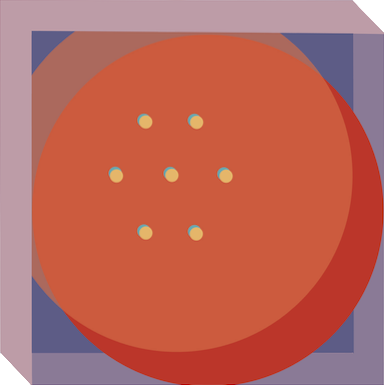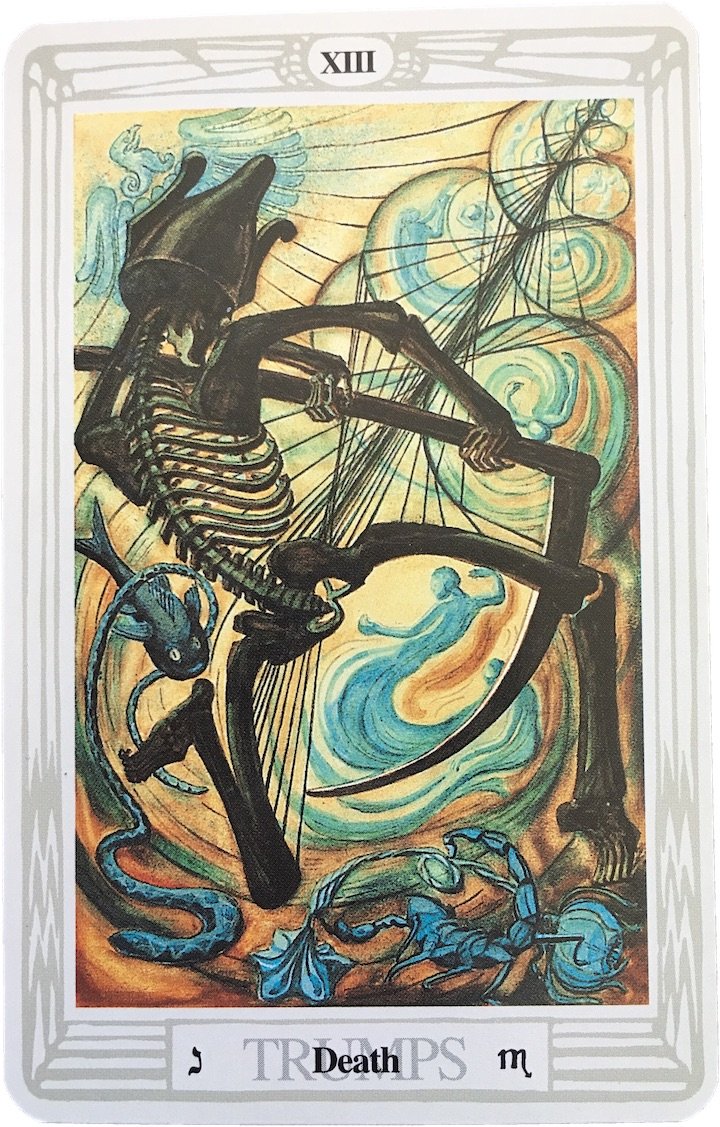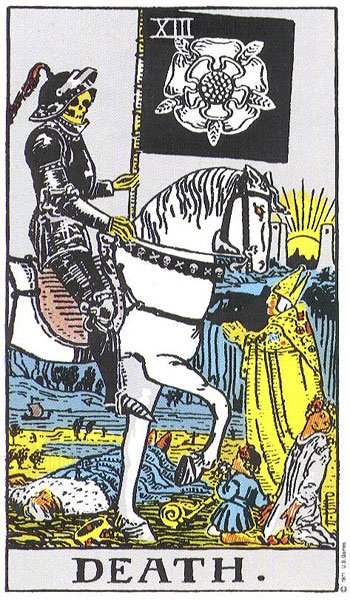DEATH : KEY XIII
The Child of the Great Transformers
The Lord of the Gate of Death
Zodiacal Trump of Scorpio
Mars Rules
Pluto Exalted
Hebrew Letter: Nun (Fish)
effect of an Act of Love; all Acts of Love contain
Pure Joy. Die daily!
Death is the apex of one curve of the snake Life:
behold all opposites as necessary complements,
and rejoice.
Alesiter Crowley
The Book of Thoth
This card is attributed to the letter Nun, which means a fish; the symbol of life beneath the waters; life travelling through the waters. It refers to the Zodiacal sign of Scorpio, which is ruled by Mars, the planet of fiery energy in its lowest form, which is therefore necessary to provide the impulse. In alchemy, this card explains the idea of putrefaction, the technical name given by its adepts to the series of chemical changes which develops the final form of life from the original latent seed in the Orphic egg.
Eagle, and Snake, and Scorpion! The Dance Of Death whirls Life from Trance to Trance to Trance.
This sign is one of the two most powerful in the Zodiac, but it has not the simplicity and intensity of Leo. It is formally divided into three parts; the lowest is symbolized by the Scorpion, which was supposed by early observers of Nature to commit suicide when finding itself ringed with fire, or otherwise in a desperate situation. This represents putrefaction in its lowest form. The strain of environment has become intolerable, and the attacked element willingly subjects itself to change; thus, potassium thrown upon water becomes ignited, and accepts the embrace of the hydroxyl radicle.
The middle interpretation of this sign is given by the serpent, who is, moreover, the main theme of the sign. [The Qabalists embodied in the Book of Genesis, Caps I and II, this doctrine of regeneration. NChSh, the Serpent in Eden, has the value 358: 50 also MShICh, Messiah. He is, accordingly, in the secret doctrine, the Redeemer. The thesis may be developed at great length. Later in the Legend, the doctrine reappears in slightly different symbolism as the story of the Flood, elsewhere in this Essay explained. Of course, the Fish is identical in essence with the Serpent; for Fish=NVN=Scorpio=Serpent. Also, Teth, the letter of Leo, means Serpent. But Fish is also the Vesica, or Womb, and Christ -and so on. This symbol resumes the whole Secret Doctrine.] The serpent is sacred, Lord of Life and Death, and its method of progression suggests the rhythmical undulation of those twin phases of life which we Call respectively life and death. The serpent is also, as previously explained, the principal symbol of male energy. From this it will be seen that this card is, in a very strict sense, the completion of the card called Lust, Atu XI, and Atu XII represents the solution or dissolution which links them.
The highest aspect of the card is the Eagle, which represents exaltation above solid matter. It was understood by the early chemists that, in certain experiments, the purest (i.e., most tenuous) elements present were given off as gas or vapour. There are thus represented in this card the three essential types of putrefaction.
The card itself represents the dance of death; the figure is a skeleton bearing a scythe, and both the skeleton and the scythe are importantly Saturnian symbols. This appears strange, as Saturn has no overt connection with Scorpio; but Saturn represents the essential structure of existing things. He is that elemental nature of things which is not destroyed by the ordinary changes which occur in the operations of Nature. Furthermore, he is crowned with the crown of Osiris; he represents Osiris in the waters of Amennti. Yet more, he is the original secret male creative God: see Atu XV. “Redeunt Saturnia regna.” It was only the corruption of the Tradition, the confusion with Set, and the Cult of the Dying God, misunderstood, deformed and distorted by the Black Lodge, that turned him into a senile and fiendish symbol.
With the sweep of his scythe he creates bubbles in which are beginning to take shape the new forms which he creates in his dance; and these forms dance also.
In this card the symbol of the fish is paramount; the fish (Il pesce, as they call him in Naples and many other places) and the serpent are the two principal objects of worship in cults which taught the doctrines of resurrection or re-incarnation. Thus we have Oannes and Dagon, fish gods, in western Asia; in many other parts of the world are similar cults. Even in Christianity, Christ was represented as a fish. The Greek work IXThUS, “which means fish And very aptly symbolizes Christ”, as Browning reminds one, was supposed to be a notariqon, the initials of a sentence meaning “Jesus Christ Son of God, Saviour”. Nor is it an accident that St. Peter was a fisherman. The Gospels, too, are full of miracles involving fish, and the fish is sacred to Mercury, because of its cold-bloodedness, its swiftness and its brilliance. There is moreover the sexual symbolism. This again recalls the function of Mercury as the guide of the dead, and as the continuing elastic element in nature.
This card must then be considered as of greater importance and catholicity than would be expected from the plain Zodiacal attribution. It is even a compendium of universal energy in its most secret form.
Joan Bunning
Death! A powerful energy indeed. Who can look at the dark, skeletal figure on Card 13 and not feel uneasy? Here we see the face of our deepest fear – our greatest unknown. We recoil from Death because we think of it as annihilation. In the tarot (and in life I would suggest) Death is not a permanent end, but a transition into a new state. Life is eternal in its essence, if not in its form. To grow, to move, to live – we must “die” to the old to give birth to the new.
It is a truism in tarot work that Card 13 rarely has anything to do with physical death. A responsible card reader never interprets Card 13 in this way because this view is too limiting. Death is not something that happens once to our bodies. It happens continually, at many levels and not just in the physical. Each moment we die to the present so the future can unfold.
In readings, Death often represents an important ending that will initiate great change. It signals the end of an era; a moment when a door is closing. At such times, there may be sadness and reluctance, but also relief and a sense of completion. Death also suggests getting down to basics. Dying has a way of making you concentrate on what’s important. This card reminds you to cut out the unnecessary. Death can also mean you will experience an inexorable force. Death is inevitable, and sometimes there are events that are inescapable as well. When these moments occur, the best approach is to ride your fate and see where it takes you.
DEATH’S ACTIONS
ENDING
closing one door to open another
bringing something to a close
completing a chapter
concluding unfinished business
putting the past behind you
having a parting of the ways
GOING THROUGH TRANSITION
changing status
moving from the known to the unknown
being cast adrift
waiting in an in-between state
being in the middle
ELIMINATING EXCESS
out what isn’t necessary
shedding old attitudes
getting down to bare bones
concentrating on essentials
getting back to basics
EXPERIENCING INEXORABLE FORCES
being in the path of sweeping change
being caught in the inescapable
going through what cannot be avoided
being part of a powerful movement
riding your fate
accepting the inevitable
DEATH’S ROLE IN THE FOOL’S JOURNEY
The Fool now begins to eliminate old habits and tired approaches. He cuts out nonessentials because he appreciates the basics of life. He goes through endings as he puts the outgrown aspects of his life behind him. He process may seem like dying because it is the death (13) of his familiar self to allow for the growth of a new one. At times this inexorable change seems to be crushing the Fool, but eventually he rises up to discover that death is not a permanent state. It is simply a transition to a new, more fulfilling way of life.
A.E. Waite
The Pictorial Key to the Tarot
Death
The veil or mask of life is perpetuated in change, transformation and passage from lower to higher, and this is more fitly represented in the rectified Tarot by one of the apocalyptic visions than by the crude notion of the reaping skeleton. Behind it lies the whole world of ascent in the spirit. The mysterious horseman moves slowly, bearing a black banner emblazoned with the Mystic Rose, which signifies life. Between two pillars on the verge of the horizon there shines the sun of immortality. The horseman carries no visible weapon, but king and child and maiden fall before him, while a prelate with clasped hands awaits his end.
There should be no need to point out that the suggestion of death which I have made in connection with the previous card is, of course, to be understood mystically, but this is not the case in the present instance. The natural transit of man to the next stage of his being either is or may be one form of his progress, but the exotic and almost unknown entrance, while still in this life, into the state of mystical death is a change in the form of consciousness and the passage into a state to which ordinary death is neither the path nor gate. The existing occult explanations of the 13th card are, on the whole, better than usual, rebirth, creation, destination, renewal, and the rest.


